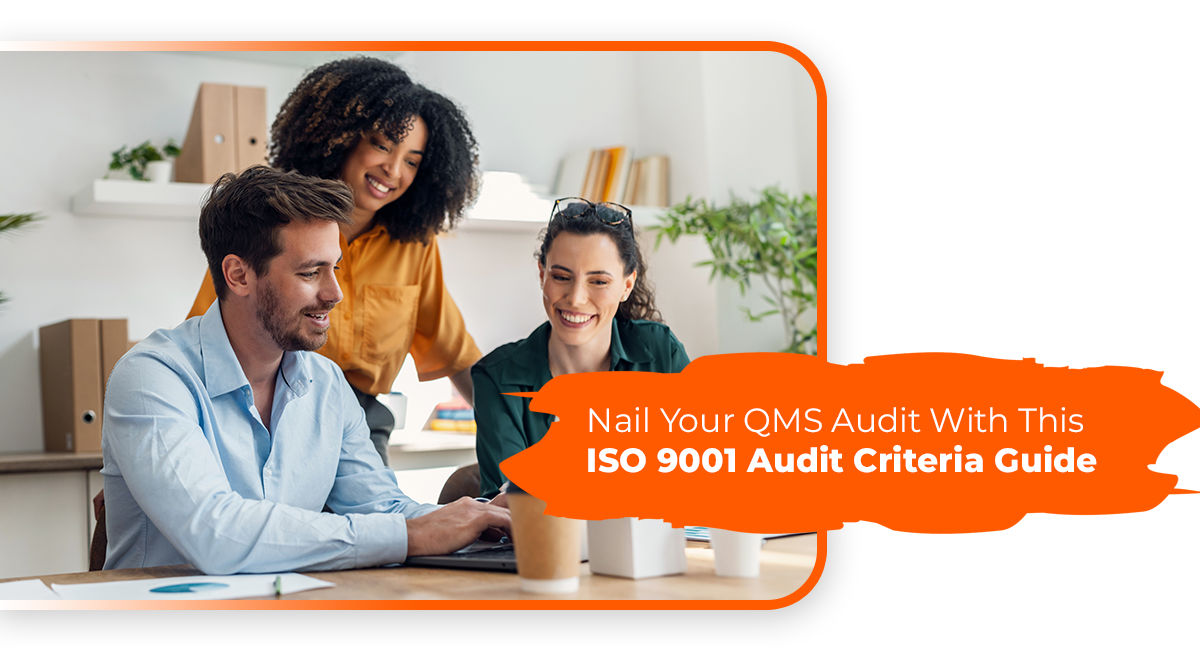QIC Global and Bluewolf operate as a single entity.
QIC Global and Bluewolf operate as a single entity.

Maintaining a compliant quality management system requires a ton of effort and resources. So, it’s only natural to want to know whether your efforts are bringing worthy outcomes.
The audit criteria in ISO 9001 allow you to achieve this through periodic audits. The standard makes it mandatory for organizations to perform audits following the requirements of clause 9.2.
Implementing this clause can enable your organization to assess the effectiveness of the system, products, services, and processes.
Also, the outcomes of the audits will act as evidence of your efforts toward improving the QMS.
So, if your organization is planning to achieve the ISO 9001 certification, continue reading to find out the standard’s criteria for audits.
Systematic, Independent And Documented
ISO 9001 quality management standard defines the audit as an independent, documented, and systematic process for obtaining evidence and evaluating fulfillment of audit criteria in ISO 9001.
ISO 9001 QMS requires organizations to conduct audits at planned intervals. The audit should aim to provide information on whether the QMS conforms to the requirements of the company and the standard. Also, it shall indicate whether you have effectively implemented and maintained the QMS.
Systematic: Your audits should be planned and scheduled. It shall have support from the top management and necessary resources for execution.
Independent: Your organization must carry out the audit in an impartial manner. To achieve this, consider appointing an auditor not responsible for the systems and products you are auditing. It will help eliminate biases and conflicts of interest.
Documented: Lastly, you shall document evidence of compliance through the audit. There are several methods for doing this, such as tests, observations, and measurements. Then, you must communicate the outcomes of the audit to the management to perform corrective actions without delay per the audit criteria in ISO 9001.
Fundamental Audit Criteria In ISO 9001
Clause 9.2.2 in ISO 9001 highlights the essential requirements for performing a quality management system audit.
1.Plan, implement, establish, and maintain an audit program
According to the standard’s criteria, you shall plan, implement, establish, and maintain an audit program. This program should consider the frequency, methods, responsibilities, reporting, and planning requirements of the audit. Additionally, it should take into account the significance of the processes you are auditing, changes that affect the organization, and the results of the previous audits.
2.Define the criteria and scope of the audit
Ensure uniformity when defining your audit criteria. It will help you assess progress and implement recommendations without additional hassles. At the same time, make sure the criteria are flexible enough for you to change as necessary and relevant to the organization’s objectives.
3.Select impartial auditors
You can choose an auditor from a third-party consultancy or from inside your company, according to the audit criteria in ISO 9001. Regardless, make sure the professional is unbiased and not involved in any activities they are responsible for auditing. It will help you avoid conflicts of interest.
4.Report to relevant management
You will need the results of the audit to determine whether the QMS complies with the ISO 9001 requirements and if you need to make any improvements in the system.
According to the standard, relevant management departments are responsible for analyzing the audit results. Hence, you must communicate the results with them.
5.Implement corrective actions without delay
If you find nonconformance in the audit results, remember to plan and take corrective measures without undue delay. Then, you must assess the effectiveness of the corrective actions in a subsequent audit.
6.Retain documentation as evidence
Ensure that your management records the audit process, its outcomes, and corrective actions and makes it easily accessible for relevant parties and events, such as external audits.
Create A Checklist For The Audit Criteria In ISO 9001
Your checklist for the audit criteria in ISO 9001 should include questions related to all the requirements of the standard, including
Context of the organization
•Understanding the organization and its context,
•Understanding the needs and expectations of interested parties,
•The scope of the quality management,
•Quality management system and its processes,
Leadership
•Leadership and commitment to the quality management system,
•Customer focus,
•Quality policy,
•Organizational roles, responsibilities, and authorities,
Planning for the quality management system
•Actions to address risks and opportunities,
•Product design skills,
•Quality objectives and planning to achieve them,
•Planning of changes,
Support
•Resources,
•People,
•Infrastructure,
•Environment for the operation of processes,
•Monitoring and measuring resources,
•Organizational knowledge,
•Competence,
•Awareness,
•Communication,
•Documentation,
Operation
•Operational planning and control,
•Determination of requirements for customer communication products and services,
•Determining requirements for products and services for audit criteria in ISO 9001,
•Review of requirements related to services and products,
•Design and development of products and services,
•Design and development planning,
•Design and development inputs,
•Design and development controls,
•Design and development outputs,
•Design and development changes,
•Control of externally provided services and products,
•Type and extent of control for external provision,
•Information for external providers,
•Productional and service provision,
•Identification and traceability,
•Property of customers or external providers,
•Preservation,
•Post-delivery activities,
•Control of changes,
•Release of products and services,
•Control of nonconforming products and services.
Performance evaluation in audit criteria in ISO 9001
•Monitoring, measurement, analysis, and evaluation,
•Customer satisfaction,
•Analysis and evaluation,
•Audit,
•Management review,
Improvement
•General improvement requirements,
•Nonconformity and corrective actions,
•Continual improvement.
Wrapping Up
The official audit criteria in ISO 9001 do not clarify how frequently you should perform the audit, along with a few other pointers. Hence, when planning the audit process, make sure to tailor it to your company’s needs. Also, ensure your audit process is completely unbiased, accurate, and documented,